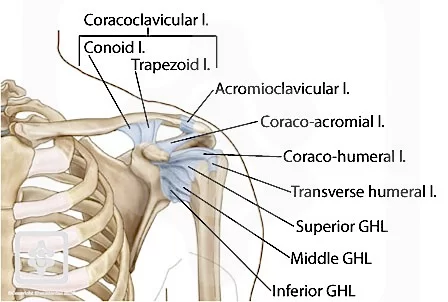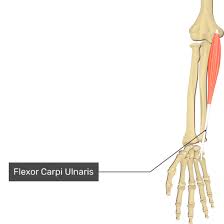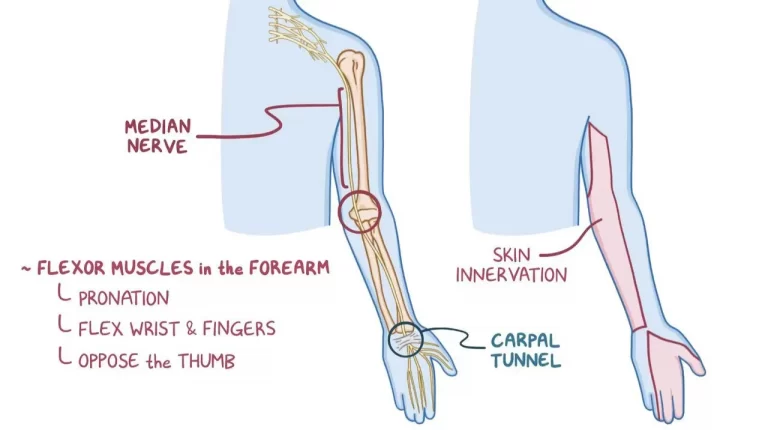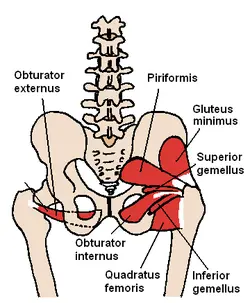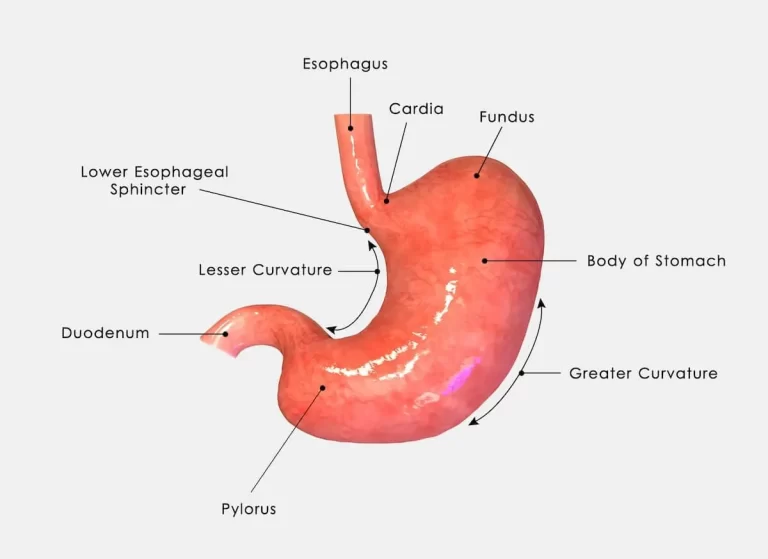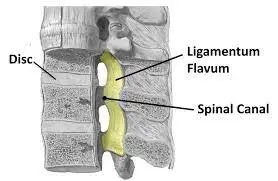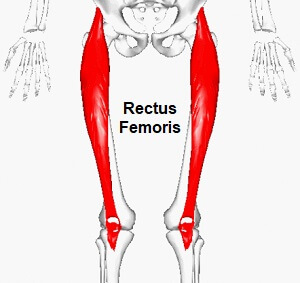Coracohumeral Ligament
Table of Contents
Introduction
The very important ligament of the shoulder joint is the coracohumeral ligament. This ligament connects the coracoid process of the scapula to the greater tubercle of the humerus. It helps to stabilize the shoulder joint by limiting excessive external rotation and abduction of the humerus.
It also plays a role in distributing forces across the joint and preventing dislocation. The coracohumeral ligament works in conjunction with the glenohumeral ligament to provide stability and function to the shoulder joint.
Structure of the Coracohumeral Ligament
The coracohumeral ligament is a strong and thick band of connective tissue that runs from the coracoid process of the scapula to the greater tubercle of the humerus. It is located on the anterior aspect of the shoulder joint and is one of the primary ligaments that helps to stabilize the joint.
The ligament is composed of dense collagen fibers that are arranged in a parallel fashion. These fibers provide the ligament with its strength and help it to resist tensile forces. The ligament also contains elastic fibers that allow it to stretch slightly under load, which helps to absorb shock and prevent injury.
The coracohumeral ligament is separated into two parts: the first is the superior and the second is the inferior bands. The superior band is thicker and stronger than the inferior band and is responsible for most of the ligament’s stabilizing function. The inferior band is thinner and more elastic, allowing for greater mobility of the shoulder joint.
The coracohumeral ligament works in conjunction with other ligaments and muscles to provide stability and function to the shoulder joint. It helps to limit excessive external rotation and abduction of the humerus, which can cause dislocation or injury to the joint. It also plays a role in distributing forces across the joint, helping to prevent damage to the surrounding tissues.
Overall, the coracohumeral ligament is an important structure in the shoulder joint that helps to provide stability and function. Its strong and elastic properties allow it to withstand the stresses placed on the joint during movement, making it an essential component of a healthy and functional shoulder.
Attachment of the Coracohumeral Ligament
The coracohumeral ligament attaches to two specific bony landmarks in the shoulder joint: the coracoid process of the scapula and the greater tubercle of the humerus.
The coracoid process is a bony projection that extends anteriorly from the scapula. The superior band of the coracohumeral ligament attaches to the coracoid process at its base, near the origin of the short head of the biceps brachii muscle. This attachment point allows the ligament to provide stability to the shoulder joint during movements that involve flexion and internal rotation of the humerus.
The greater tubercle is a bony prominence on the lateral aspect of the humerus, located just above the level of the shoulder joint. The inferior band of the coracohumeral ligament attaches to the greater tubercle, specifically to a small depression called the lesser tuberosity. This attachment point allows the ligament to provide stability to the shoulder joint during movements that involve external rotation and abduction of the humerus.
Together, these two attachment points allow the coracohumeral ligament to provide stability to the shoulder joint in multiple planes of movement. By anchoring onto both the scapula and humerus, the ligament helps to prevent excessive movement and potential injury to the joint.
The Function of the Coracohumeral Ligament
The coracohumeral ligament is an important structure that plays a critical role in stabilizing the shoulder joint. It is a strong, fibrous band that connects the coracoid process of the scapula to the greater tubercle of the humerus. The ligament is composed of two distinct bands, the superior and inferior bands, which attach to different bony landmarks in the shoulder joint.
The primary function of the coracohumeral ligament is to provide stability to the shoulder joint during movement. This is particularly important during movements that involve flexion, extension, internal rotation, external rotation, and abduction of the humerus. The ligament acts as a restraint, preventing excessive movement and potential injury to the joint.
During flexion and internal rotation of the humerus, the superior band of the coracohumeral ligament provides stability by attaching to the coracoid process at its base. This attachment point allows the ligament to resist excessive anterior translation of the humeral head, which could otherwise lead to dislocation or subluxation of the joint.
During external rotation and abduction of the humerus, the inferior band of the coracohumeral ligament provides stability by attaching to the greater tubercle of the humerus at the lesser tuberosity. This attachment point allows the ligament to resist excessive posterior translation of the humeral head, which could otherwise lead to instability or impingement in the joint.
In addition to providing stability during movement, the coracohumeral ligament also plays a role in maintaining the integrity of other structures in the shoulder joint. For example, it helps to support the long head of the biceps tendon and prevent it from slipping out of its groove in the humerus.
So in the end, the coracohumeral ligament is an essential structure for maintaining stability and preventing injury in the shoulder joint. Its attachment points on the scapula and humerus allow it to provide stability in multiple planes of movement, making it a crucial component of the shoulder’s complex biomechanics.
Blood supply of the Coracohumeral Ligament
The blood supply to the coracohumeral ligament comes from several sources. The primary source is the suprascapular artery, which arises from the thyrocervical trunk of the subclavian artery. The suprascapular artery gives off several branches that supply the shoulder joint, including the coracohumeral ligament.
Moreover, the anterior and posterior circumflex humeral arteries also contribute to the blood supply of the coracohumeral ligament. These arteries arise from the axillary artery and provide collateral circulation to the shoulder joint.
The blood supply to the coracohumeral ligament is important for maintaining its structural integrity and preventing injury. Injuries to the ligament can cause instability and dislocation of the shoulder joint, which can lead to chronic pain and functional impairment. Therefore, maintaining good blood flow to the ligament is essential for optimal shoulder function.
Symptoms of the coracohumeral ligament
Symptoms of coracohumeral ligament injuries can vary depending on the severity of the injury. Some common symptoms include:
- Pain: Pain is the most common symptom of a coracohumeral ligament injury. The pain may be dull or sharp and is usually felt in the front of the shoulder or upper arm. The pain may worsen when the arm is raised or moved.
- Weakness: Injuries to the coracohumeral ligament can cause weakness in the shoulder and arm. This weakness may make it difficult to lift or move the arm.
- Instability: The coracohumeral ligament plays an important role in stabilizing the shoulder joint. Injuries to the ligament can cause instability in the joint, which may lead to dislocation or subluxation.
- Limited range of motion: Injuries to the coracohumeral ligament can limit the range of motion in the shoulder joint. This may make it difficult to perform daily activities such as reaching overhead or lifting objects.
- Swelling and bruising: In more severe cases, swelling and bruising may occur around the shoulder joint.
If a person feels any of these symptoms, it is important to take medical treatment. A healthcare professional can diagnose the injury and recommend appropriate treatment, which may include rest, physical therapy, or surgery.
Injuries of the Coracohumeral Ligament
The coracohumeral ligament is a small but important ligament located in the shoulder joint. It connects the coracoid process of the scapula to the greater tubercle of the humerus and helps to stabilize the shoulder joint during movement. There are several activities that can cause injury to the coracohumeral ligament, including:
- Repetitive overhead movements: Activities that involve repetitive overhead movements, such as throwing a ball, swimming, or painting, can put a lot of stress on the coracohumeral ligament. Over time, this can lead to wear and tear and eventually result in an injury.
- Trauma: A direct blow to the shoulder or a fall onto an outstretched arm can cause a sudden injury to the coracohumeral ligament. This type of injury is more common in contact sports or activities with a high risk of falls.
- Poor posture: Poor posture can also contribute to coracohumeral ligament injuries. Slouching or hunching over can put extra strain on the ligament and increase the risk of injury.
- Shoulder impingement: Shoulder impingement occurs when the rotator cuff tendons and other soft tissues in the shoulder become compressed between the bones of the shoulder joint. This can put extra stress on the coracohumeral ligament and increase the risk of injury.
- Aging: As we age, our ligaments and other connective tissues become less elastic and more prone to injury. This can make the coracohumeral ligament more susceptible to wear and tear and increase the risk of injury.
It is very crucial to take the necessary steps to prevent coracohumeral ligament injuries by maintaining good posture, using proper technique during physical activity, and gradually increasing the intensity and duration of exercise over time. If you do experience symptoms of a coracohumeral ligament injury, seek medical attention to prevent further damage and promote healing.
Diagnosis of the coracohumeral ligament
The coracohumeral ligament is a thick band of connective tissue that connects the coracoid process of the scapula to the greater tubercle of the humerus. It provides stability to the shoulder joint and limits excessive external rotation and inferior translation of the humeral head.
To diagnose an injury to the coracohumeral ligament, a thorough physical examination is necessary. The following steps may be taken:
- Medical history: The healthcare provider will ask about the patient’s symptoms, including pain, weakness, and limitations in range of motion.
- Physical examination: The healthcare provider will perform a physical examination of the shoulder joint, looking for signs of instability or weakness. They may also perform special tests, such as the lift-off test or the belly-press test, to assess the integrity of the rotator cuff muscles and other structures in the shoulder joint.
- Imaging studies: If a diagnosis cannot be made based on the physical examination alone, imaging studies may be ordered. X-rays can help rule out other conditions, such as fractures or arthritis, while magnetic resonance imaging (MRI) can provide detailed images of soft tissues, including ligaments.
- Diagnostic injection: In some cases, a diagnostic injection may be used to confirm a diagnosis. A local anesthetic and steroid medication are injected into the shoulder joint, and if the patient experiences significant pain relief, it may indicate an injury to the coracohumeral ligament.
In general, a mixture of medical history, physical examination, imaging studies, and diagnostic injections may be used to diagnose an injury to the coracohumeral ligament. Treatment options will depend on the severity of the injury and may include rest, physical therapy, medications, or surgery.
Special test
The coracoid impingement test
The coracoid impingement test is a special test that is used to assess the integrity of the coracohumeral ligament. This ligament is located in the shoulder joint and helps to stabilize the humerus bone in the socket of the shoulder blade.
To perform the coracoid impingement test, the patient is positioned in a seated or standing position with their arm at their side. The examiner then grasps the patient’s elbow and flexes their arm to 90 degrees while internally rotating it. The examiner then places their other hand on the coracoid process, which is a bony projection on the front of the shoulder blade.
The examiner then applies pressure to the coracoid process while asking the patient if they experience any pain or discomfort. If the maneuver reproduces pain or discomfort in the area of the coracohumeral ligament, it may indicate an injury to the ligament.
The coracoid impingement test is often used in conjunction with other special tests and physical examination techniques to assess shoulder injuries. It is important to note that a positive result on this test does not necessarily mean that there is an injury to the coracohumeral ligament, as there may be other structures in the shoulder joint that can cause pain or discomfort with this maneuver.
Treatment of the Coracohumeral Ligament
Conservative treatment
Conservative treatment for an injury to the coracohumeral ligament aims to reduce pain, and inflammation, and restore function to the shoulder joint. The following are some of the conservative treatment options for the coracohumeral ligament:
- Rest: Resting the shoulder joint and avoiding activities that aggravate the injury is essential for healing. A sling may be used to immobilize the shoulder and reduce stress on the injured ligament.
- Ice therapy: The application of ice to the injured area can help in reducing pain, swelling, and inflammation. Ice application should be done for 20 minutes at a time, several times a day.
- Physical therapy: A physical therapist can design an exercise program to strengthen the muscles around the shoulder joint and improve the range of motion. Exercises may involve stretching, range-of-motion exercises, and strengthening exercises.
- Medications: Over-the-counter nonsteroidal anti-inflammatory drugs (NSAIDs) such as ibuprofen or naproxen can help in reducing pain and inflammation.
- Corticosteroid injections: If conservative treatment does not provide relief, a corticosteroid injection may be recommended. A corticosteroid injection can help reduce pain and inflammation in the shoulder joint.
- Platelet-rich plasma (PRP) therapy: PRP therapy involves injecting a concentrated solution of platelets from the patient’s own blood into the affected area. Platelets have growth factors that can help in stimulating healing.
So in general, conservative treatment for an injury to the coracohumeral ligament aims to reduce pain, and inflammation, and restore function to the shoulder joint. It is important to work with a healthcare provider to develop a treatment plan that is appropriate for the severity of the injury.
Physiotherapy treatment
Physiotherapy treatment for an injury to the coracohumeral ligament involves a combination of exercises and manual therapy techniques to reduce pain, and inflammation, and restore function to the shoulder joint. The following are some of the physiotherapy treatments that may be used for an injury to the coracohumeral ligament:
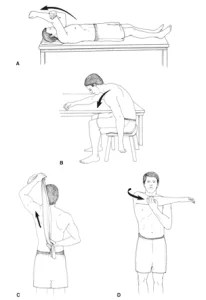
Range-of-motion exercises: These exercises aim to improve the range of motion of the shoulder joint. The physiotherapist may use passive or active-assisted range-of-motion exercises to gently move the shoulder joint through its full range of motion.
Strengthening exercises: Strengthening exercises aim to improve the strength of the muscles around the shoulder joint. The physiotherapist may use resistance bands, weights, or bodyweight exercises to target specific muscles.
Manual therapy: Manual therapy techniques such as massage, joint mobilization, and soft tissue mobilization may be used to reduce pain and inflammation in the shoulder joint. The physiotherapist may use hands-on techniques to manipulate the soft tissues and joints around the shoulder joint.
Posture correction: Poor posture can be responsible for shoulder pain and dysfunction. The physiotherapist may provide advice on how to improve posture and may prescribe exercises to strengthen the muscles that support good posture.
Education and advice: The physiotherapist may provide education on how to manage symptoms at home and may provide advice on how to prevent future injuries.
In conclusion, physiotherapy treatment for an injury to the coracohumeral ligament aims to reduce pain and inflammation, improve the range of motion and strength, and restore function to the shoulder joint. It is important to work with a qualified physiotherapist who can design a treatment plan that is appropriate for your individual needs.
Risk factors of the Coracohumeral Ligament Injury
The coracohumeral ligament is a strong band of connective tissue that connects the coracoid process of the scapula to the greater tubercle of the humerus. It provides stability to the shoulder joint and helps to prevent dislocation. However, there are several risk factors that can increase the likelihood of injury to the coracohumeral ligament. These include:
- Repetitive overhead activities: People who participate in sports or occupations that require repetitive overhead movements, such as baseball pitchers, swimmers, and construction workers, are at increased risk of developing an injury to the coracohumeral ligament.
- Trauma: A direct blow or fall onto the shoulder can cause damage to the coracohumeral ligament.
- Age: As we age, our connective tissues become less elastic and more prone to injury. Older adults may be at increased risk of developing an injury to the coracohumeral ligament.
- Poor posture: Poor posture can place additional stress on the shoulder joint and increase the risk of developing an injury to the coracohumeral ligament.
- Weakness or imbalances in surrounding muscles: Weakness or imbalances in the muscles that support the shoulder joint can increase the likelihood of developing an injury to the coracohumeral ligament.
- Previous shoulder injuries: People who have previously experienced a shoulder injury, such as a rotator cuff tear, may be at increased risk of developing an injury to the coracohumeral ligament.
It is very crucial to be aware of these risk factors and take steps in order to prevent injury to the coracohumeral ligament. This may include proper warm-up and stretching before physical activity, maintaining good posture, and participating in regular strength and conditioning exercises to improve muscle strength and balance around the shoulder joint.
How to prevent coracohumeral ligament injury?
To prevent injury to the coracohumeral ligament, it is important to take certain precautions and follow good practices. Here are some tips to prevent injury to the coracohumeral ligament:
- Warm-up and stretching: Before engaging in any physical activity, it is important to warm up and stretch properly. This will help to prepare the muscles and joints for the activity and reduce the risk of injury.
- Proper technique: When participating in sports or other activities that involve overhead movements, it is important to use proper technique. This will help to reduce the stress on the shoulder joint and decrease the risk of injury.
- Strengthening exercises: Regular strength and conditioning exercises can help to improve muscle strength and balance around the shoulder joint. This will help to provide greater stability and reduce the risk of injury.
- Posture: Maintaining a good posture can help to reduce stress on the shoulder joint and decrease the risk of injury. This includes sitting up straight, keeping the shoulders back and relaxed, and avoiding slouching.
- Rest and recovery: Adequate rest and recovery are important for preventing injury. It is important to allow the body time to recover between physical activities and to avoid overuse of the shoulder joint.
- Seek medical attention: If you experience any pain or discomfort in the shoulder joint, it is important to seek medical attention. Early diagnosis and treatment can help in preventing further injury and promote faster recovery.
By following these tips, you can help to prevent injury to the coracohumeral ligament and maintain a healthy shoulder joint.
FAQ
The coracohumeral ligament is a strong band of connective tissue that connects the coracoid process of the scapula to the greater tubercle of the humerus.
The coracohumeral ligament helps to stabilize the shoulder joint by limiting excessive movement of the humerus.
Symptoms of a coracohumeral ligament injury may include pain, weakness, limited range of motion, and instability in the shoulder joint.
A coracohumeral ligament injury can be diagnosed through a physical examination, imaging tests such as X-rays or MRI, and sometimes through arthroscopy.
Treatment options for a coracohumeral ligament injury may include rest, ice, physical therapy, anti-inflammatory medication, and in severe cases, surgery.
Recovery time from a coracohumeral ligament injury can vary depending on the severity of the injury and the treatment plan. Mild injuries may take a few weeks to heal, while more severe injuries may take several months or longer.
While it may not always be possible to prevent a coracohumeral ligament injury, maintaining good posture, avoiding repetitive overhead activities, and strengthening the muscles around the shoulder joint can help reduce the risk of injury.

